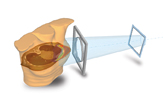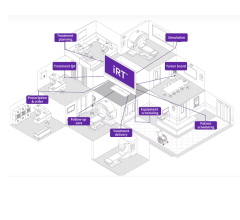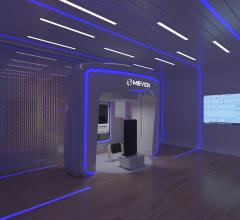
RayStation Version 4.5
As radiation therapy becomes more sophisticated and new methods are devised for treating cancer, treatment planning systems have become an essential tool for physicians and physicists. While new features are being added to improve the functionality of various radiotherapy systems, the end goal is still the same — contouring the radiation beam to treat the cancerous tissue while minimizing exposure to any surrounding healthy tissue.
In recent years, treatment planning systems have advanced significantly in several areas, including adaptation to multiple treatment types, image fusion and improved dose monitoring.
Tailoring to New Treatments
Being able to accommodate multiple emerging modalities has been one of the primary drivers of development in treatment planning systems. There are a host of techniques being used for radiation therapy today, from proton therapy to intensity-modulated radiation therapy (IMRT) to volumetric modulated arc therapy (VMAT) and beyond. Each method makes use of radiation in different ways, and healthcare providers need to make sure they are enacting the most effective treatment plan for each and every patient, regardless of modality.
Allegheny General Hospital in Pittsburgh has been using Elekta’s Monaco treatment planning system since it hit the market, according to Ellen Day, Ph.D., senior medical physicist. When the hospital first implemented the system, they were using it primarily with IMRT. After updating the main hospital and two others in the network to the Monaco 5 system in 2014, they are now able to do 3-D conformal radiation therapy. They have yet to do so, according to Day, as 3-D is typically used in less complex cases such as breast cancer when there are fewer extraneous organs to be concerned about exposing to the radiation. “All of our head and neck patients are planned on Monaco though, specifically because it’s so good for organ-at-risk bearing,” she added.
Froedtert & the Medical College of Wisconsin Clinical Cancer Center also began using the Monaco 5 system in 2014, implementing it in tandem with Siemens’ modulated arc (mARC) therapy technique.1 mARC is a form of VMAT that offers advantages over IMRT in terms of radiation delivery speed and dose conformity. On the first mARC case following implementation, the therapy team was able to deliver the two-arc treatment in just eight minutes, according to X. Allen Li, Ph.D., chief physicist in the department of radiation oncology.
Proton therapy is one of the fastest-growing radiation therapy treatments in the United States, with proton centers popping up all over the country. The Provision Center for Proton Therapy in Knoxville, Tenn., opened in January 2014 using the RayStation treatment planning system from RaySearch Laboratories.2 Pencil beam scanning, a form of intensity-modulated proton therapy (IMPT) and one of the most advanced forms of proton therapy, is the preferred treatment type at the center, according to Marcio Fagundes, M.D., medical director, because it allows radiation oncologists to contour the intensity and spatial distribution of the beam to maximize the dose to the target area. The center employs version 4.0 of RayStation, which added various tools for optimization of pencil beam scanning in 2014 following U.S. Food and Drug Administration (FDA) 510(k) approval.
“You can actually stop the radiation before it goes too far into a critical structure,” said Fagundes. He highlighted RayStation’s ability to select how to prioritize which protons should have more or less weight or importance, and to select the best angle with the least obstruction. “It’s really individualizing how you will distribute the dose,” he added.
Fusion Improving Accuracy
Regardless of the type of radiation therapy used, medical imaging is an integral part of the process to assess the patient both pre- and post-treatment. As one might expect, however, there can be compatibility issues between different imaging modalities and different treatment planning systems. To combat these problems, treatment planning systems have begun implementing image fusion modules to successfully combine images for improved contouring. Some modules make use of deformable image registration (DIR), which finds point-to-point correspondence between positions in comparable scans and can adjust images to account for differing positions.3
Speaking to Allegheny General, Day said that image fusion is especially helpful for head and neck patients. The hospital will take magnetic resonance imaging (MRI) scans initially to better delineate lesions from surrounding tissue. Dose calculations, however, can only be made through computed tomography (CT) in Monaco, so after doing initial treatment planning (and incorporating the expected position of the patient), they’ll get another MRI scan which will be imported into Monaco. Monaco does not have DIR capability, which means that “if the patient is in a slightly different position, it makes it harder to get an accurate representation of where that lesion is,” Day said.
RayStation also sports image fusion capabilities, focusing on computed tomography (CT), positron emission tomography (PET) and MRI.
Dose Tracking
While radiation is a key component of both radiology and cancer treatment, strong concerns about the amount of radiation patients are exposed to has arisen over the last several years among the public and in government circles. This has led to a number of states and even some federal jurisdictions implementing low-dose and/or dose-monitoring mandates. While some dose-reduction cases are a matter of technique, more and more devices are starting to incorporate features for monitoring and/or lowering delivered dose.
Treatment planning systems are no exception. One of the more popular dose calculation methods employed by numerous systems is the Monte Carlo dose algorithm, which provides quick, accurate calculations, “so you know what you’re delivering, you know the dose at the surface of the skin is what you’re getting, whereas a lot of other planning algorithms aren’t as accurate in the at-the-skin area,” said Day.
The Monaco 5 is one example of a system using the Monte Carlo dose engine, which has produced satisfactory results for multiple users. Day at Allegheny Health Network said that using Monte Carlo, Monaco 5 is able to complete a plan with dose calculations in just 15 minutes. “When we first started using Monaco,” she said, “you’d start a calculation and you’d leave for the night; you come back in the morning and it would have just finished.”
On the first Monaco 5 mARC case at Froedtert & the Medical College of Wisconsin, Li reported they were able to achieve 99 percent agreement between the measured dose distribution and the plan dose distribution. “And we’ve been able to replicate this accuracy in most of the cases measured so far,” he added.
Version 4.5 of RayStation, which gained FDA approval last November, has its own series of dose tracking features, compounding the inherent low-dose benefits of proton therapy. RaySearch also completely rewrote the calculation algorithms to dramatically increase computation speed.4
Automation Coming Around
For all of the advancements in multimodality treatment and dose monitoring, automation of protocols remains an area needing further improvement in treatment planning systems. Several systems released in the last few years, however, are making strides.
Monaco 5 is one example of a template-driven treatment planning system. “You can make changes, but you cannot create a treatment plan without starting from a template,” said Day. For example, prostate cancer patients might begin treatment with IMRT or 3-D conformal radiotherapy, but then switch to brachytherapy seeds after a certain point. Day said that the system had around 20 templates when they began using it, but Allegheny is now creating their own templates as user comfort increases.
Version 4.5 of RayStation introduced the rayAutoBreast module to create automated tangential breast IMRT treatment plans. Key components of the automation process include:
• Automatic detection of radio-opaque markers defining the breast
• Automatic contouring of all the relevant target and risk organs
• Automatic setup of beams, including heuristic optimization of gantry and collimator angles
• Automatic creation of objective functions, optimization and segmentation settings and clinical goals
Philips has taken steps toward greater automation as well with its Pinnacle3 system, which received FDA approval in August 2014. Users can quickly generate high-quality IMRT and VMAT plans with limited intervention thanks to a scripting tool that records and plays back the steps of the planning process.
References
1. “Froedtert & the Medical College of Wisconsin First in U.S. to Use Monaco 5 Treatment Planning with Siemens mARC Radiotherapy Technique,” http://www.itnonline.com/article/froedtert-medical-college-wisconsin-first-us-use-monaco-5-treatment-planning-siemens-marc-ra. Accessed Feb. 24, 2015.
2. “Proton Therapy Center Offers East TN New Cancer Treatment,” http://www.wbir.com/story/news/health/2014/01/22/proton-therapy-center-opens/4782543/. Accessed March 5, 2015.
3. Noe, Karsten Ostergaard. “Deformable Image Registration for Use in Radiotherapy Using GPU Acceleration.” http://informahealthcare.com/doi/abs/10.1080/02841860802258760. Accessed March 5, 2015.
4. “RaySearch Receives FDA Clearance for RayStation 4.5,” www.itnonline.com, Nov. 3, 2014. Accessed March 4, 2015.



 December 04, 2025
December 04, 2025 









